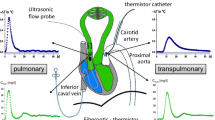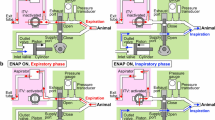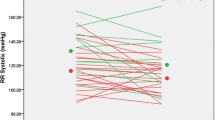Abstract
Since the introduction of the flow-directed pulmonary artery catheter by Swan et al [30] the pulmonary capillary wedge pressure (PCWP) has been applied more and more as an indicator of circulating volume status. It has been thought that left atrial pressure (LAP) reflects LV preload. Therefore experimental and clinical evaluations of the pulmonary artery catheter were focussed on comparisons between PCWP and LAP, and it was found that there is an acute correlation between LAP and PCWP during spontaneous breathing (SB) and intermittent positive pressure ventilation (IPPV) [1, 5, 9, 12, 15, 17, 34].
Access this chapter
Tax calculation will be finalised at checkout
Purchases are for personal use only
Preview
Unable to display preview. Download preview PDF.
Similar content being viewed by others
References
Batson GA, Chandrasekhar KP, Payas Y, Rickards DF (1972) Measurement of pulmonary wedge pressure by flow directed Swan-Ganz catheter. Cardiovasc Res 6: 748–752
Bellamy PE, Mercurio P (1986) An alternative method for coordinating pulmonary capillary wedge pressure measurements with the respiratory cycle. Crit Care Med: 14: 733–734
Berne RM, Levy MN (1983) The cardiovascular system. In: Berne RM, Levy MN (eds) Physiology. Mosby, St. Louis, pp 439–623
Berryhill RE, Benumo JL, Raucher LA (1978) Pulmonary vascular pressure reading at the end of exhalation. Anesthesiology 49: 365–369
Buchbinder N, Ganz W (1976) Hemodynamic monitoring: invasive techniques. Anesthesiology 45: 146–155
Calvin JE, Driedger AA, Sibbald WJ (1981) Positive end-expiratory pressure (PEEP) does not depress left ventricular function in patients with pulmonary edema. Am Rev Resp Dis 124: 121–128
Cassidy SS, Ramanathan M (1984) Dimensional analysis of the left ventricle during PEEP: relative septal and lateral wall displacements. Am J Physiol 15: H792–H805
Davison R, Parker M, Harrison RA (1978) The validity of determinations of pulmonary wedge pressure during mechanical ventilation. Chest 73: 352–358
De Laurentis DA, Hayes M, Matsumoto T, Wolferth CC (1972) Does central venous pressure accurately reflect hemodynamic and fluid volume patterns in the critical surgical patient? Am J Surg 126: 415–418
Divertie MB, McMichan JC, Michel L, Offord KP, Ness AB (1983) Avoidance of aggravated hypoxemia during measurement of mean pulmonary artery wedge pressure in ARDS. Chest 83: 70–74
Fewell, JE, Abendschein DR, Carlson CJ, Rapaport E, Murray JF (1981) Continuous positive pressure ventilation does not alter ventricular pressure volume relationships. Am J Physiol 240: H821–H826
Fitzpatrick DF, Hampson LG, Burgess JH (1972) Bedside determination of left atrial pressure. Can Med Assoc J 106: 1293–1298
Gershan JA (1983) Effect of positive end-expiratory pressure on pulmonary capillary wedge pressure. Heart Lung 12: 143–148
Haynes JB, Carson SD, Whitney WP, Zerbe GO, Hyers TM, Steele P (1980) Positive end-expiratory pressure shifts left ventricular diastolic pressure-area curves. J Appl Physiol 48: 670–676
Humphrey CB, Oury JH, Virgilio RW, Gibbons JA, Folkerth TL, Shapiro AR, Fosburg RG (1976) An analysis of direct and indirect measurements of left atrial filling pressure. J Thorac Cardiovasc Surg 71: 643–647
Jardin F, Farcot JC, Guret P, Prost JF, Ozier Y, Bourdarias JP (1984) Echocardiographic evaluation of ventricles during continuous positive airway pressure breathing. J Appl Physiol 56: 619–627
Lappas D, Lell WA, Gabel JC, Civetta JM, Lowenstein E (1973) Indirect measurement of left-atrial pressure in surgical patients. Pulmonary-capillary wedge and pulmonary artery diastolic pressures compared with left-atrial pressure. Anesthesiology 38: 394–397
Laver MB, Strauss WH, Pohost GM(1979) Right and left ventricular geometry adjustments during acute respiratory failure. Crit Care Med 7: 507– 519
Marini JJ, Culver BH, Butler J (1981) Effect of positive end-expiratory pressure on canine ventricular function curves. J Appl Physiol 51: 1367– 1374
Marini JJ, Culver BH, Butler J (1981) Mechanical effect of lung distension with positive pressure on cardiac function. Am Rev Resp Dis 124: 282–286
O’Quin R, Marini JJ (1983) Pulmonary artery occlusion pressure: clinical physiology, measurement and interpretation. Am Rev Respir Dis 128: 319–326
Pace NL (1977) A critique of flow-directed pulmonary arterial catheterization. Anesthesiology 47: 455–465
Pfeiffer U, Birk M, Kohler W, Sagerer M, Blümel G (1981) Extravasales Lungenwasser und plasmakolloidosmotischer Druck bei der pulmonalen Mikroembolie. Chir Forum 81: 28–32
Rankin JS, Olsen CO, Arentzen CE, Tyson GS, Maier G, Smith PK, Hammon JW, Davis JW, McHale PA, Anderson RW, Sabiston DC (1982) The effects of airway pressure on cardiac function in intact dogs and man. Circulation 66: 108–120
Rice RL, Awe RJ, Gaasch WH (1974) Wedge pressure measurements in obstructive pulmonary disease. Chest 66: 628–632
Robertson CH, Cassidy SS (1976) Distribution of the reduced cardiac output induced by continuous positive-pressure breathing. Physiologist 19: 341–344
Schreuder JJ, Jansen JRC, Versprille A (1985) Hemodynamic effects of PEEP applied as a ramp in normo-, hyper-, and hypovolemia. J Appl Physiol 59: 1178–1184
Shasby DA, Dauber IA, Pfister S, Anderson JT, Carson SB, Manart F, Myers TM (1981) Swan-Ganz catheter location and left atrial pressure determine the accuracy of the wedge pressure when positive end-expiratory pressure is used. Chest 80: 666–670
Sibbald WJ, Driedger AA, Meyers ML, Short AJ, Wells GA (1983) Biventricular function in the adult respiratory distress syndrome. Chest 84: 126–134
Swan HJC, Ganz W, Forrester J, Marcus H, Diamond G, Chonette D (1970) Catheterization of the heart in man with use of a flow-directed balloon-tipped catheter. N Engl J Med 283: 447– 451
Tooker J, Huseby J, Butler J (1978) The effect of Swan-Ganz catheter height on the wedge pressure-left atrial pressure relationship in edema during positive pressure ventilation. Am Rev Resp Dis 117: 721–725
Vatner SF, Boettcher DH (1978) Regulation of cardiac output by stroke volume and heart rate in conscious dogs. Circ Res 42: 557
Vlahakes GJ, Turley K, Hoffman JIE (1981) The pathophysiology of failure in acute right ventricular hypertension: hemodynamic and biochemical correlations. Circulation 63: 87–95
Walston A, Kendall ME (1973) Comparison of pulmonary wedge and left atrial pressure in man. Am Heart J 86: 159–164
Wise RA, Robotham JL, Bromberger-Barnea B, Permutt S (1981) Effect of PEEP on left ventricular function in right-heart-bypassed dogs. J Appl Physiol 51: 541–546
Zarins CK, Virgilio RW, Smith DE, Peters RM (1977) The effect of vascular volume on positive end-expiratory pressure induced cardiac output depression and wedge-left atrial pressure discrepancy. J Surg Res 23: 348–360
Editor information
Editors and Affiliations
Rights and permissions
Copyright information
© 1990 Springer-Verlag Berlin Heidelberg
About this paper
Cite this paper
Wellhöfer, H., Zeravik, J., Perker, M., Blümel, G., Zimmermann, G., Pfeiffer, U.J. (1990). PEEP-Induced Changes of Pulmonary Capillary Wedge Pressure, Prepulmonary and Total Intrathoracic Blood Volume in Anesthetized Dogs. In: Lewis, F.R., Pfeiffer, U.J. (eds) Practical Applications of Fiberoptics in Critical Care Monitoring. Springer, Berlin, Heidelberg. https://doi.org/10.1007/978-3-642-75086-1_4
Download citation
DOI: https://doi.org/10.1007/978-3-642-75086-1_4
Publisher Name: Springer, Berlin, Heidelberg
Print ISBN: 978-3-540-51718-4
Online ISBN: 978-3-642-75086-1
eBook Packages: Springer Book Archive




